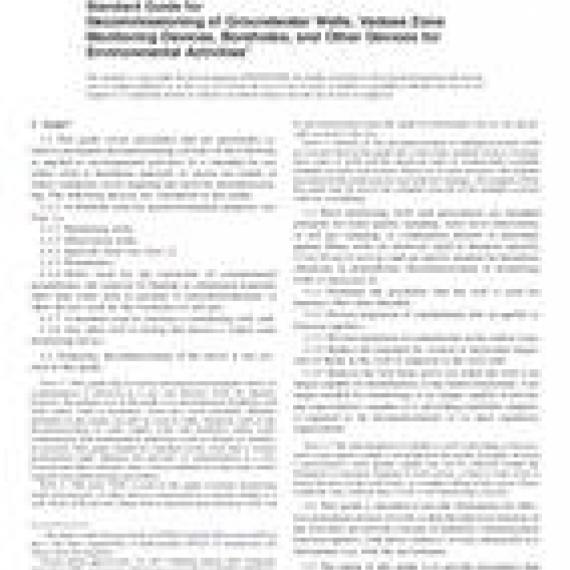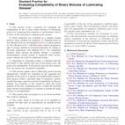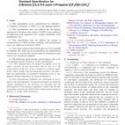No products
ASTM D5299/D5299M-17
ASTM D5299/D5299M-17 Standard Guide for Decommissioning of Groundwater Wells, Vadose Zone Monitoring Devices, Boreholes, and Other Devices for Environmental Activities
standard by ASTM International, 12/15/2017
Full Description
1.1This guide covers procedures that are specifically related to permanent decommissioning (closure) of the following as applied to environmental activities. It is intended for use where solid or hazardous materials or wastes are found, or where conditions occur requiring the need for decommissioning. The following devices are considered in this guide:
1.1.1A borehole used for geoenvironmental purposes (see Note 1),
1.1.2Monitoring wells,
1.1.3Observation wells,
1.1.4Injection wells (see Note 2),
1.1.5Piezometers,
1.1.6Wells used for the extraction of contaminated groundwater, the removal of floating or submerged materials other than water such as gasoline or tetrachloroethylene, or other devices used for the extraction of soil gas,
1.1.7A borehole used to construct a monitoring well, and
1.1.8Any other well or boring that houses a vadose zone monitoring device.
1.2Temporary decommissioning of the above is not covered in this guide.
Note 1:This guide may be used to decommission boreholes where no contamination is observed at a site (see Practice D420 for details); however, the primary use of the guide is to decommission boreholes and wells where solid or hazardous waste have been identified. Methods identified in this guide can also be used in other situations such as the decommissioning of water supply wells and boreholes where water contaminated with nonhazardous pollutants (such as nitrates or sulfates) are present. This guide should be consulted in the event that a routine geotechnical study indicates the presence of contamination at a site. Consult and follow national, state, or local regulations as they may control required decommissioning procedures.
Note 2:The term well is used in this guide to denote monitoring wells, piezometers, or other devices constructed in a manner similar to a well. Some of the devices listed such as injection and extraction wells can be decommissioned using this guide for information, but are not specifically covered in the text.
Note 3:Details on the decommissioning of multiple-screened wells are not provided in this guide due to the many methods used to construct these types of wells and the numerous types of commercially available multiple-screened well systems. However, in some instances, the methods presented in this guide may be used with few changes. An example of how this guide may be used is the complete removal of the multiple-screened wells by overdrilling.
1.3Most monitoring wells and piezometers are intended primarily for water quality sampling, water level observation, or soil gas sampling, or combination thereof, to determine quality. Many wells are relatively small in diameter typically 2.5 to 20 cm [1 to 8 in.] and are used to monitor for hazardous chemicals in groundwater. Decommissioning of monitoring wells is necessary to:
1.3.1Eliminate the possibility that the well is used for purposes other than intended,
1.3.2Prevent migration of contaminants into an aquifer or between aquifers,
1.3.3Prevent migration of contaminants in the vadose zone,
1.3.4Reduce the potential for vertical or horizontal migration of fluids in the well or adjacent to the well, and
1.3.5Remove the well from active use when the well is no longer capable of rehabilitation, or has failed structurally; is no longer needed for monitoring; is no longer capable of providing representative samples or is providing unreliable samples; is required to be decommissioned; or to meet regulatory requirements.
Note 4:The determination of whether a well is providing a representative water quality sample is not defined in this guide. Examples of when a representative water quality sample may not be collected include the biological or chemical clogging of well screens, a drop in water level to below the base of the well screen, or complete silting of the screen. These conditions may indicate that a well is not functioning correctly.
1.4This guide is intended to provide information for effective permanent closure of wells so that the physical structure of the well does not provide a means of hydraulic communication between aquifers, with above surfaces, or react chemically in a detrimental way with the environment.
1.5The intent of this guide is to provide procedures that when followed result in a reasonable level of confidence in the integrity of the decommissioning activity. However, it may not be practicable to verify the integrity of the decommissioning procedure. At this time, methods are not available to substantially determine the integrity of the decommissioning activity.
1.6This guide may also be used for closure or decommissioning of other systems that could allow vertical or horizontal migration of contaminants or other cross-contamination of aquifers, or when ordered by regulatory agencies.
1.7Units-The values stated in either SI units or inch-pound units (given in brackets) are to be regarded separately as standard. The values stated in each system may not be exact equivalents; therefore, each system shall be used independently of the other. Combining values from the two systems may result in non-conformance with the standard.
1.8All observed and calculated values shall conform to the guidelines for significant digits and rounding established in Practice D6026, unless superseded by this standard.
1.9This standard does not purport to address all of the safety concerns, if any, associated with its use. It is the responsibility of the user of this standard to establish appropriate safety, health, and environmental practices and determine the applicability of regulatory limitations prior to use.
1.10This guide offers an organized collection of information or a series of options and does not recommend a specific course of action. This document cannot replace education or experience and should be used in conjunction with professional judgment. Not all aspects of this guide may be applicable in all circumstances. This ASTM standard is not intended to represent or replace the standard of care by which the adequacy of a given professional service must be judged, nor should this document be applied without consideration of a project's many unique aspects. The word Standard in the title of this document means only that the document has been approved through the ASTM consensus process.
Note 5:If state and local regulations are in effect where the decommissioning is to occur, the regulations take precedence over this guide.
1.11This international standard was developed in accordance with internationally recognized principles on standardization established in the Decision on Principles for the Development of International Standards, Guides and Recommendations issued by the World Trade Organization Technical Barriers to Trade (TBT) Committee.


































